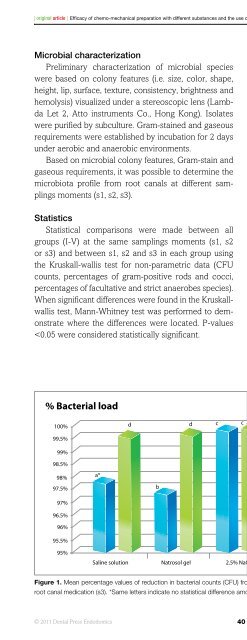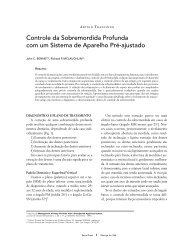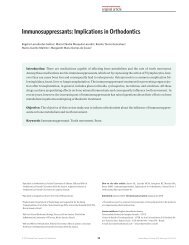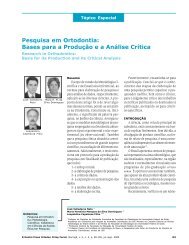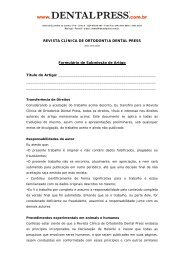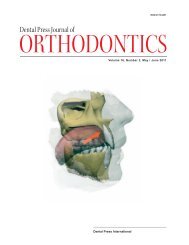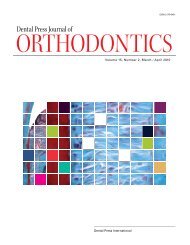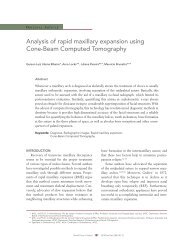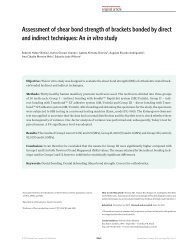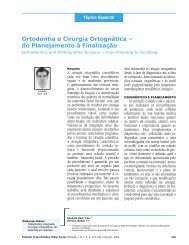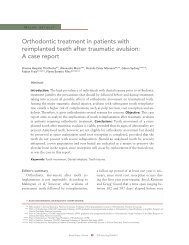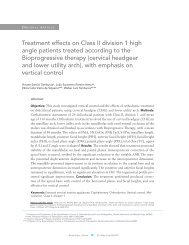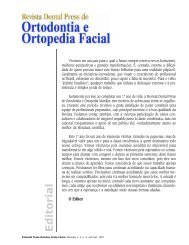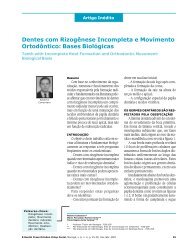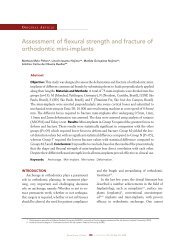[ original article ] The persistence of different calcium hydroxide paste medications in root canals: an SEM studystudies that found the removal of calcium hydroxidebaseddressings extremely difficult or even impossible.13-21,23The use of pure Ca(OH) 2as intracanal dressing,although reported in some studies, 18,28 seem to beboth impractical clinically in narrow canals and notdesirable, since ionic diffusion would be minimal. Inthe present study, it was used merely as a control, toallow comparison with other formulations. Althoughthe lower persistence in the root canal system reportedin the results, the use of such medicationwithout a vehicle does not seem to be suitable ordesirable clinically.Propylene glycol or polyethylene glycol used asvehicles provide a viscous consistency to the paste,which facilitates the insertion in the root canal, leadingsome authors to prefer this formulation. The slowrelease of ions and resorption by the surroundingtissues are also among the qualities advocated. 5,11,12However, results suggest that removal of viscouspastes may be more difficult than other formulations,causing an excess of medication remaining at the apicallevel of the root canal. Similar findings were foundby Lambrianidis et al 15 and Nandini et al, 18 but usingcommercially available pastes based on methylcelluloseor silicone oil, respectively. Other authors foundno differences regarding Ca(OH) 2medication persistenceassociated to different vehicles. 23,28Association of Ca(OH) 2with saline solution showedto be easier to remove from the root canals than propyleneor polyethylene glycol, but still persisted ingreater amounts when compared to glycerin used asvehicle. Other studies may be necessary to understandthe reasons of the lower amounts of Ca(OH) 2found onthe Ca(OH) 2+ glycerin group (GIV).Conclusions1. Pure calcium hydroxide based medications orits association to glycerin allows an easier removalfrom the root canal.2. The association of Ca(OH) 2with polyethyleneglycol or propylene glycol 400 determines ahigher persistence of the medication inside thecanal prior to obturation.3. None of the intracanal medications could betotally removed from the root canals.© 2011 <strong>Dental</strong> <strong>Press</strong> Endodontics 80<strong>Dental</strong> <strong>Press</strong> Endod. 2011 apr-june;1(1):77-81
Onoda HK, Yoshinari GH, Pereira KFS, Delben AAST, Zárate P, Guerisoli DMZReferences1. Byström A, Sundqvist G. Bacteriologic evaluation of the efficacy ofmechanical root canal instrumentation in endodontic therapy. ScandJ Dent Res. 1981 Aug;89(4):321-8.2. Estrela C, Sydney GB, Bammann LL, Felippe O Junior. Mechanismof action of calcium and hydroxyl ions of calcium hydroxide on tissueand bacteria. Braz Dent J. 1995;6(2):85-90.3. Estrela C, Pimenta FC, Ito IY, Bammann LL. Antimicrobial evaluationof calcium hydroxide in infected dentinal tubules. J Endod. 1999Jun;25(6):416-8.4. Siqueira JF, Lopes HP. Mechanisms of antimicrobial activityof calcium hydroxide: a critical review. Int Endod J. 1999May;32(5):361-9.5. Fava LRG, Saunders WP. Calcium hydroxide pastes: classificationand clinical indications. Int Endod J. 1999 Apr;32(4):257-82.6. Trope M, Moshonov J, Nissan R, Buxt P, Yesilsoy C. Short vs longterm calcium hydroxide treatment of established inflammatory rootresorption in replanted dog teeth. Endod Dent Traumatol. 1995Jun;11(3):124-8.7. Tronstad L, Andreasen JO, Hasselgren G, Kristerson L, Riis I.pH changes in dental tissues after root canal filling with calciumhydroxide. J Endod. 1981 Jan;7(1):17-21.8. Krakow AA, Berk H, Gron P. Therapeutic induction of root formationin the exposed incompletely formed tooth with vital pulp. Oral SurgOral Med Oral Pathol. 1977 May;43(5):755-65.9. Walia T, Chawla HS, Gauba K. Management of wide open apices innon-vital permanent teeth with Ca(OH) 2paste. J Clin Pediatr Dent.2000 Fall;25(1):51-6.10. Estrela C, Pécora JD, Sousa-Neto MD, Estrela CR, Bammann LL.Effect of vehicle on antimicrobial properties of calcium hydroxidepastes. Braz Dent J. 1999;10(2):63-72.11. Leonardo MR, Silva LAB, Utrilla LS, Leonardo RT, Consolaro A.Effect of intracanal dressings on repair and apical bridging of teethwith incomplete root formation. Endod Dent Traumatol. 1993Feb;9(1):25-30.12. Simon ST, Bhat KS, Francis R. Effect of four vehicles on the pH ofcalcium hydroxide and the release of calcium ion. Oral Surg Oral MedOral Pathol. 1995 Apr;80(4):459-64.13. Ricucci D, Langeland K. Incomplete calcium hydroxide removal fromthe root canal: a case report. Int Endod J. 1997 Nov;30(6):418-21.14. Margelos J, Eliades G, Verdalis C, Palaghias G. Interaction of calciumhydroxide with zinc oxide eugenol type sealers: a potential clinicalproblem. J Endod. 1997 Jan;23(1):43-8.15. Lambrianidis T, Margelos J, Beltes P. Removal efficiency ofcalcium hydroxide dressing from the root canal. J Endod.1999Feb;25(2):85-8.16. Kuga MC, Tanomaru-Filho M, Faria G, Só MVR, Galletti T, BavelloJRS. Calcium hydroxide intracanal dressing removal with differentrotary instruments and irrigating solutions: a scanning electronmicroscopy study. Braz Dent J. 2010;21(4):310-4.17. Wiseman A, Cox TC, Paranjpe A, Flake NM, Cohenca N, JohnsonJD. Efficacy of sonic and ultrasonic activation for removal ofcalcium hydroxide from mesial canals of mandibular molars: amicrotomographic study. J Endod. 2011 Fev;37(2):235-8.18. Nandini S, Velmurugan N, Kandaswamy D. Removal efficiency ofcalcium hydroxide intracanal medicament with two calcium chelators:volumetric analysis using spiral CT, an in vitro study. J Endod. 2006Dec;32(12):1097-101.19. van der Sluis LWM, Wu MK, Wesselink PR. The evaluation of removalof calcium hydroxide paste from an artificial standardized groovein the apical root canal using different irrigation methodologies. IntEndod J. 2007 Jan;40(1):52-7.20. Kim SK, Kim YO. Influence of calcium hydroxide intracanalmedication on apical seal. Int Endod J. 2002 Jul;35(7):623-8.21. Böttcher DE, Hirai VH, Silva UX Neto, Grecca FS. Effect of calciumhydroxide dressing on the long-term sealing ability of two differentendodontic sealers: an in vitro study. Oral Surg Oral Med Oral PatholOral Radiol Endod. 2010 Sep;110(3):386-9.22. Çalt S, Serper A. Dentinal tubule penetration of root canal sealersafter root canal dressing with calcium hydroxide. J Endod. 1999Jun;25(6):431-3.23. da Silva JM, Andrade CV Junior, Zaia AA, Pessoa OF. Microscopiccleanliness evaluation of the apical root canal after using calciumhydroxide mixed with chlorhexidine, propylene glycol, or antibioticpaste. Oral Surg Oral Med Oral Pathol Oral Radiol Endod. 2011Feb;111(2):260-4.24. Porkaew P, Retief DH, Barfield RD, Lacefield WR, Soong S. Effects ofcalcium hydroxide paste as an intracanal medicament on apical seal.J Endod. 1990 Aug;16(8):369-74.25. Holland R, Alexandre AC, Murata SS, Dos Santos CA, Dezan EJúnior. Apical leakage following root canal dressing with calciumhydroxide. Endod Dent Traumatol. 1995 Dec;11(6):261-3.26. Kontakiotis EG, Wu MK, Wesselink PR. Effect of calcium hydroxidedressing on seal of permanent root filling. Endod Dent Traumatol.1997 Dec;13(6):281-4.27. Wu MK, Kontakiotis EG, Wesselink PR. Decoloration of 1%methylene blue solution in contact with dental filling materials. J Dent.1998 Sep;26(7):585-9.28. Balvedi RPA, Versiani MA, Manna FF, Biffi JCG. A comparison of twotechniques for the removal of calcium hydroxide from root canals. IntEndod J. 2010 Sep;43(9):763-8.© 2011 <strong>Dental</strong> <strong>Press</strong> Endodontics 81<strong>Dental</strong> <strong>Press</strong> Endod. 2011 apr-june;1(1):77-81


